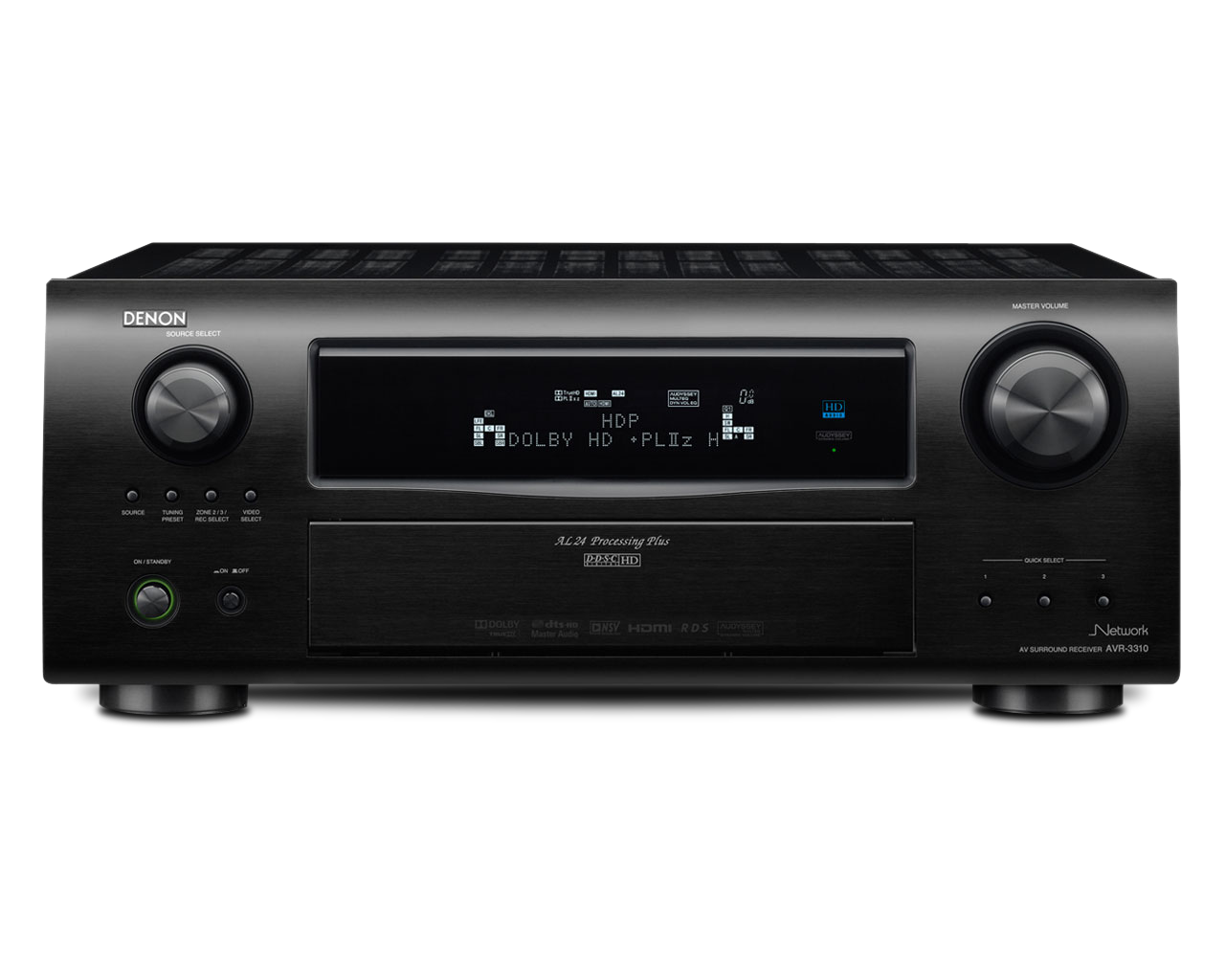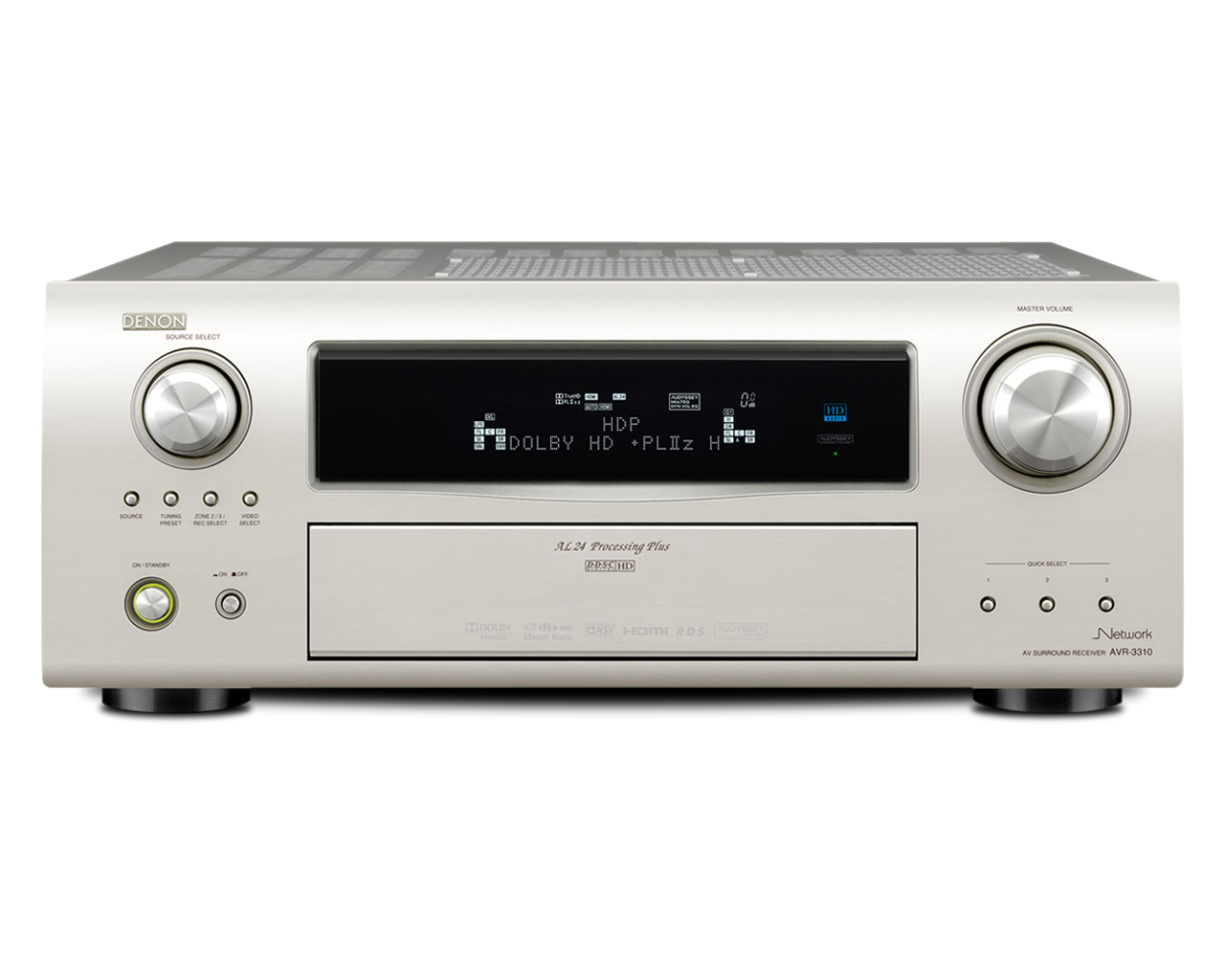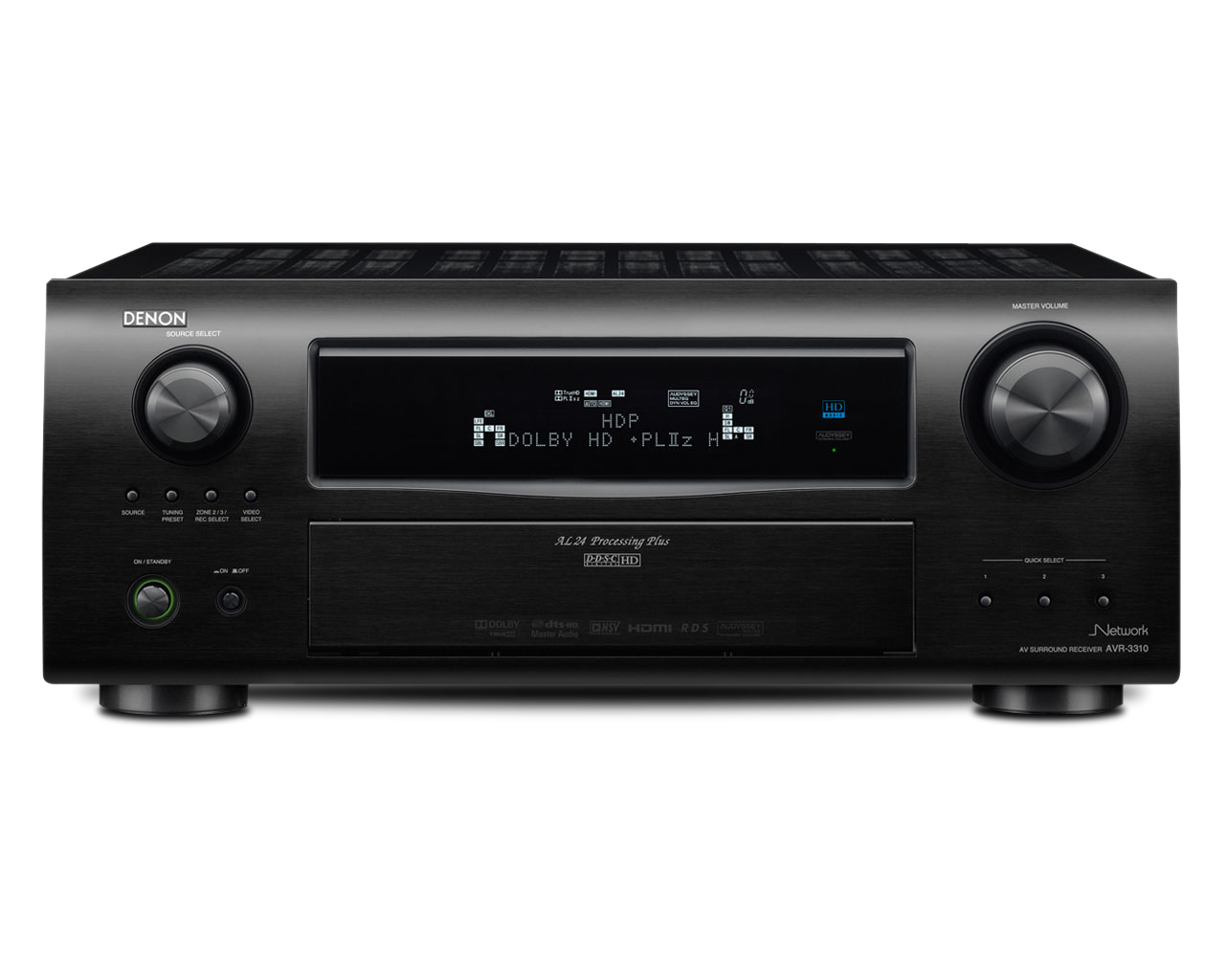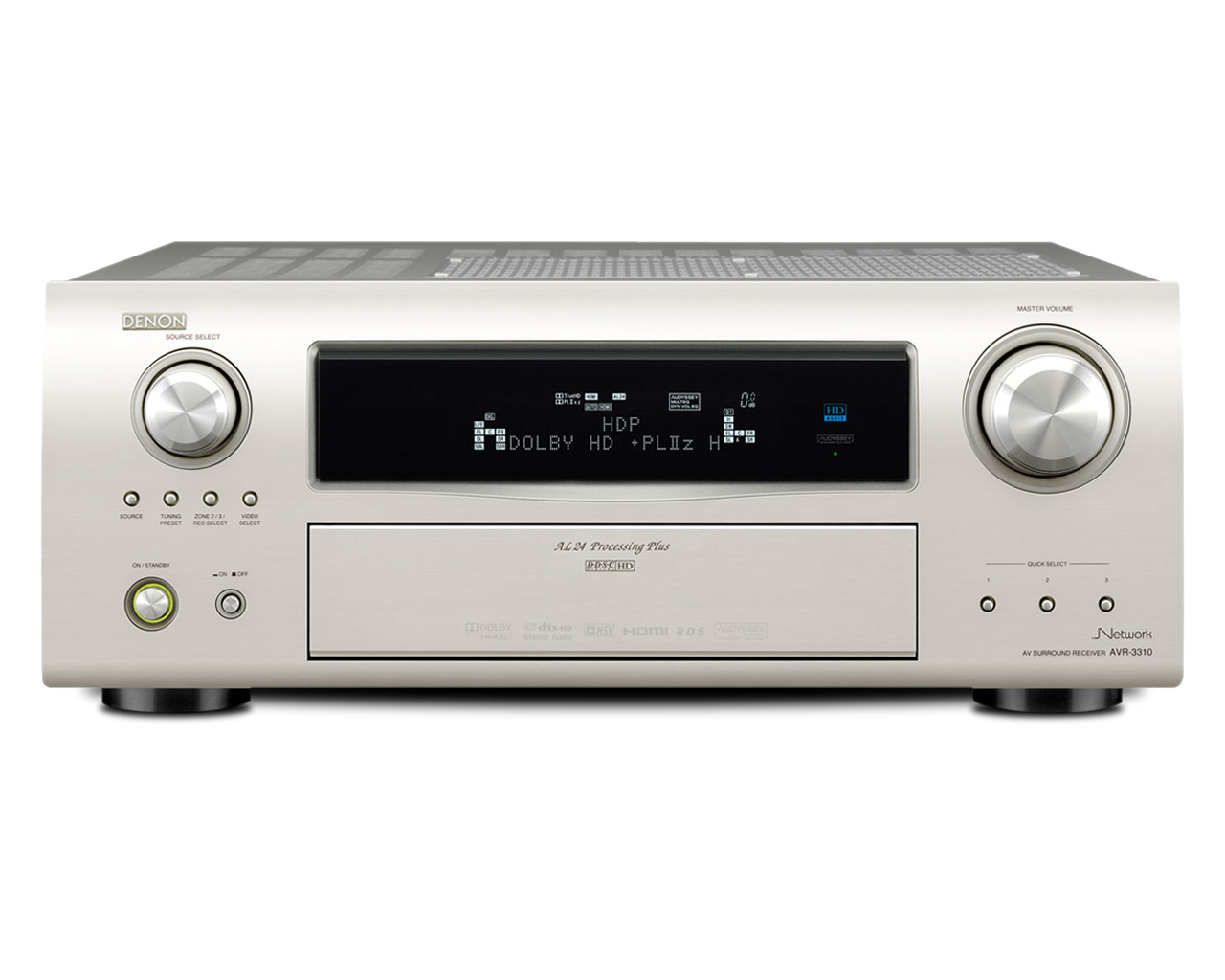Features - AVR-3310
- Clock Jitter Reducer available for all digital inputs
- Dolby Pro Logic IIz processing
- HDMI one cable connection (Analogue Video to HDMI Up conversion) to your HDTV. Click here for a detailed demo.
- High bit i/p converter and scaler up to 1080p (Multi-cadence detection for SD and HD video signal / Digital noise reduction and detail enhancer
- 5 x HDMI in / 1 x HDMI out (Repeater and Scaler)
- Enhance network capability
- Sleep timer function
- Identical quality and power for all 7 channels, 160W x 7ch (6 ohms)
- Dynamic Discrete Surround Circuit, D.D.S.C.-HD: New 32-bit floating point high precision DSP processor / AL24 Processing Plus, to dramatically enhance the music listening experience / Differential D/A Converters
- Stable power supply for high-quality sound and picture playback
- Compressed Audio Restorer to enhance digital music files
- Dolby TrueHD and dts-HD Master Audio decoders
- DENON’s high picture quality circuitry, to enhance enjoyment of existing DVDs
- Video digital noise reduction, to optimize effects for both SD and HD content
- Bi-amp capability
- Internet Radio and Network audio/photo streaming from PC/MAC, server
- USB mass storage support for audio and photo playback (MTP compatible)
- 3 source / 3 zone capability
- Power amplifier, assign for zone 2 or 3
- Possible Software-Update via Internet
- On-Board GUI, Superimposed on HDMI (up to 1080p)
- Audyssey Dynamic Volume, for real-time volume adjustment
- Audyssey Dynamic EQ and Audyssey MultEQ Auto setup and Room EQ
- 2-line fluorescent display on front panel
- Three Quick Select Buttons
- Pre memory & learning remote control unit + zone remote control unit
- Remote Installer Access via DPMS
- PC setup via Ethernet (Web setup)
- Premium Silver
- Black
7-channel A/V surround receiver that not only offers high-bit i/p conversion and scaling along with other acclaimed DENON audio and video technologies, but also lets users enjoy a wide variety of media such as Network Audio and Photo Streaming
New Features
State-of-the-art DENON Solutions
Connectivity & Future-ready Expandability
Ease-of-Use
Custom Integration
Colour Variations
TECHNOLOGY- AVR-3310
-
 AL24 Processing Plus
AL24 Processing PlusDenon has further developed its proprietary AL24 Processiing, an analog waveform reproduction technology, to support the 192-kHz sampling frequency of DVD-Audio. This new technology, called AL24 Processing Plus, thoroughly suppresses quantization noise with D/A conversion of LPCM signals to reproduce the low-level signals with optimum clarity that brings out all the delicate nuances of the music. In high-end models, AL24 Processing Plus for all channels.
-
 ALPHA Processing
ALPHA ProcessingALPHA processing is the world's first technical formula for reproducing an analog waveform from the reproduction of 16-bit data in 20-bit quality. The ALPHA processer interpolates the digital data recorded on a CD and reproduces it in a waveform that is very close to the way these musical signals would look in a natural analog waveform.
-
 Audyssey MultEQ-XT with Dynamic EQ
Audyssey MultEQ-XT with Dynamic EQ -
 Auto Setup and Auto Room EQ with Audyssey MultEQ XT
Auto Setup and Auto Room EQ with Audyssey MultEQ XTThe Audyssey MultEQ XT allows room correction and calibration technology. During the Auto Set-Up mode, MultEQ XT automatically determines how many loudspeakers are connected, whether they are connected in phase and whether they are satellites or subwoofers. When it has processed this it then analyzes and calibrates speaker level, size, and distance. In addition, MultEQ XT detects the proper crossover point and determines correct frequency response for up to eight listener positions simultaneously. This is the first system to optimize and compensate the system for more than one listening location at the same time giving nearly every listener in the room a "sweet spot" no matter where they're sitting. Denon's implementation of MultEQ XT uses multiple Texas Instruments' Aureus DSP processors with high-end digital-to-analog converters. Both the Room EQ and Auto Set-Up features can be disabled if required.
For more information go to; http://www.audyssey.com/ and also;
http://www.audioholics.com/techtips/specsformats/AudysseyMultEQ.php -
 BD (Blu-ray Disc) Video
BD (Blu-ray Disc) VideoEine Blu-ray Disc (BD), deren Maximum an Speicherkapazität für die Aufzeichnung von hochaufgelöstem Video-Material (High Definition, HD) benutzt wird. Die Mehrkanaltonaufzeichnung kann in vielfältiger Weise erfolgen: datenreduziert (mit Dolby Digital, DTS, Dolby Digital Plus, DTS-HD High Resolution Audio), unkomprimiert (mit PCM) oder verlustlos komprimiert (mit Dolby TrueHD, DTS-HD Master Audio).
-
 Cinema Equalizer
Cinema EqualizerThe sound from movie sources recorded in Dolby Digital, DTS, or other formats emphasizes high-frequency range due to a theater’s front speakers being placed behind the movie screen. If this sound is reproduced in the home theater without correction, the high-frequency range is too strong. Denon amplifiers feature a Cinema Equalizer to correct these high-frequency components so that the sound is clearer and easier to listen to. (For Dolby Digital, Dolby Pro Logic II, and DTS surround modes.)
-
 D.D.S.C. HD Digital
D.D.S.C. HD DigitalD.D.S.C.-HD for high-quality high definition Sound Reproduction: DDSC (Dynamic Discrete Surround Circuit)-HD (High Definition) Digital is a circuit configuration specially designed by Denon in which all elements of the surround processor are optimized through the use of selected high-performance discrete components, including separate A/D and D/A converters, with sophisticated HD DSP surround decoding.
-
 DLNA Certified
DLNA Certified -
 Dolby Digital EX
Dolby Digital EXIn a movie theater, film soundtracks that have been encoded with Dolby Digital surround EX technology are able to reproduce an extra channel which has been added during the mixing of the program. This channel, called Surround Back, places sounds behind the listener in addition to the currently available front left, front center, front right, surround right, surround left and subwoofer channels. The additional channel provides the opportunity for more detailed imaging behind the listener and brings more depth, spacious ambience and sound localization then ever before. Dolby Digital EX is not available in the system without surround back speaker(s).
-
 Dolby Digital-Decoder
Dolby Digital-DecoderDolby Digital is the multi-channel digital signal format developed by Dolby Laboratories. Dolby Digital consists of up to "5.1" channels - front left, front right, center, surround left, surround right and an additional channel exclusively reserved for additional deep bass sound effects (the Low Frequency Effects - LFE - channel, also called the ".1" channel, containing bass frequencies of up to 120Hz).
Unlike the analog Dolby Pro Logic format, Dolby Digital's main channels can all contain full range sound information, from the lowest bass, up to the highest frequencies - 22kHz. The signals within each channel are distinct from the others, allowing pinpoint sound imaging and Dolby Digital offers tremendous dynamic range from the most powerful sound effects to the quietest, softest sounds, free from noise and distortion. -
 Dolby Pro Logic II
Dolby Pro Logic IIThe Dolby Pro Logic ll decoder reproduces dynamic 5.1-channel surround sound from 2-channel sources such as TV, videos and CDs. Dolby Pro Logic ll uses matrix-decoding technology that has been dramatically improved over Pro Logic. With Pro Logic ll, for instance, the Surround channels are in stereo instead of just mono with Pro Logic, and playback covers the full frequency range instead of just up to 7kHz with Pro Logic. These improvements let you enjoy a wide variety of 2-channel sources with the exciting effects of 5.1-channel surround sound. In Dolby Pro Logic ll, there is a Movie mode (*1) that creates a sound field for movies, a Music mode that does the same for music, and a Pro Logic emulation feature that reproduces sound effects in the way that conventional Pro Logic does.
Dolby Pro Logic II Music: The music mode creates a rich and enveloping surround ambience delivered to the subwoofer, optimizing the visceral of planned rear effects. This mode can only be used with 2-channel audio sources.
Dolby Pro Logic II Cinema: The Cinema mode is optimized for movies or programs with Dolby Surround soundtracks. This mode is also appropriate for use with video game.
Dobly Pro Logic II Game: The game mode was implemented to ensure that the bass impact from pure surround effects are fully delivered to the subwoofer, optimizing the visceral of panned rear effects. This mode can only be used with 2-channel audio sources. -
 Dolby Pro Logic IIx
Dolby Pro Logic IIxDolby Pro Logic IIx is an extension of Dolby Pro Logic II technology. This highly sophisticated algorithm processes native stereo and 5.1 channel content to produce 6.1 or 7.1 output channels. And Dolby Pro Logic IIx is not available in the system without surround back speaker(s).
Dolby Pro Logic IIx Music: The music mode creates a rich and enveloping surround ambience delivered to the subwoofer, optimizing the visceral of planned rear effects. This mode can only be used with 2-channel audio sources.
Dolby Pro Logic IIx Cinema: The Cinema mode is optimized for movies or programs with Dolby Surround soundtracks. This mode is also appropriate for use with video game. -
 Dolby TrueHD
Dolby TrueHDDolby TrueHD is a completely loss-free Audio-Codec for high resolution audio for up to 8 channels Supporting 24-Bit and sampling rates up to 192 kHz. It requires specific Dolby HD decoders. Since the resulting signal is bit-to-bit to the master you can achieve the ultimate in audio quality.
-
 DTS 96/24
DTS 96/24DTS 96/24 allows high-quality 5.1 channel sound playback with full-quality, full-motion video. DTS 96/24 allows both digital audio output and video output from your existing DVD player and is backward compatible with existing DTS decoders for normal DTS 5.1 playback. DTS 96/24 actually exceeds the resolution of most film soundtrack masters to date, and will initially apply mainly to high quality DTS music DVD discs.
-
 DTS Neo:6 Cinema & DTS-Neo:6 Music
DTS Neo:6 Cinema & DTS-Neo:6 MusicThis mode decodes 2-channel signals into 6-channel signals using high accuracy digital matrix technology. The DTS NEO:6 decoder has near discrete properties in the frequency characteristics of the channels as well as in channel separation.
According to the signals being played back, DTS NEO:6 Cinema mode optimized for playback or the DTS NEO:6 Music mode optimized for music playback.
-
 DTS-Decoder
DTS-DecoderA data compression method developed by Digital Threater Systems that takes six channels of audio (5.1) and folds them into a single digital bitstream. This differs from Dolby Digital in that the data rate is a somewhat higher 1.4 Mbs, which represents a compression ratio of about 4 to 1.In order to take advantage of this DVD feature, a DTS decoder is required. DTS decoders are installed internally in Denon players and A/V recievers.
-
 DTS-ES Discrete/Matrix 6.1
DTS-ES Discrete/Matrix 6.1DTS-ES Extended Surround is a multi-channel digital signal format develpoed by Digital Theater Systems Inc. While offering high compatibility with the conventional DTS Digital Surround format, DTS-ES greatly improves the 360 degree surround impression and space expression thanks to further expanded surround signals. This format has been used professionally in movie theaters since 1999.
In addition to the 5.1 surround channels, DTS-ES also offers the surround back channel for surround playback with a total of 6.1 channels. DTS-ES includes two signal formats with different surround signal recording methods, as DTS-ES Discrete 6.1 and DTS-ES Matrix 6.1.
DTS-ES Discrete 6.1
DTS-ES Discrete 6.1 is the newest recording format. With it, all 6.1 channels (including the SB channel) are recorded independently using a digital discrete system. The main feature of this format is that because the SL, SR and SB channels are fully independent, the sound can be designed with total freedom and it is possible to achieve a sense that the acoustic images are moving about freely among the background sounds surrounding the listener from 360 degrees. Though maximum performance is achieved when sound tracks recorded with this system are played using a DTS-ES decoder, when played with a conventional DTS decoder the SB channel signals are automatically
down-mixed to the SL and SR channels, so none of the signal components are lost.
DTS-ES Matrix 6.1
With this format, the additional SB channel signals undergo matrix encoding and are input to the SL and SR channels beforehand. Upon playback they are decoded to the SL, SR and SB channels. The performance of the encoder used at the time of recording can be fully matched using a high precision digital matrix decoder developed by DTS, thereby achieving surround sound more faithful to the producer’s sound design aims than with conventional 5.1- or 6.1-channel systems. In addition, the bit stream format is 100% compatible with conventional DTS signals, so the effect of the Matrix 6.1 format can be achieved even with 5.1-channel signal sources. Of course it is also possible to play DTS-ES Matrix 6.1 encoded sources with a DTS 5.1-channel decoder. -
 DTS-HD
DTS-HDDTS-HD (High Definition) is a progression of DTS for high performance audio supporting upto 8 channels with a resolution of 24-Bit and sampling of upto 192 kHz. The differences between the formats is as follows:
DTS-HD High Resolution Audio
This format works like DTS however it uses a more effective compression algorithm, offering greater compression, the result is an audio signal almost bit for bit to the master while requiring a smaller amount of data.
DTS-HD Master Audio
This format is completely lossless with only minimal compression. The resulting audio signal is bit-for-bit to the master giving you the optimum in audio quality.
A/V-Receivers with this logo can decode both formats, BD- or HD-DVD-Players with this logo can either decode or output the DTS-HD signal via HDMI. -
 Flip Remote - Simple ergonomic remote with two control levels
Flip Remote - Simple ergonomic remote with two control levelsWith the "Flip remote" from DENON, operation of our products becomes far more straight forward. The remote layout has been cleared up, on the top side only the keys for the most important functions are present, in different sizes for easier location. All the most important functions glow in the dark and are well readable during typical home cinema lighting. Under a flap on the back of the remote hiden away are the additional buttons for less frequent adjusments.
-
 HDMI-output (HDCP)
HDMI-output (HDCP)HDMI (high definition multimedia interface), a new connector that bases itself on the DVI-HDCP model. HDMI supports uncompressed high definition video plus multi-channel audio in a single cable using a smaller connector that eliminates the need for multiple cables in home entertainment systems, simplifying installation and eliminating cross technology confusion. It transmits uncompressed digital video so that the picture maintains a high quality of color depth, brightness and contrast. It also supports Consumer Electronics Control (CEC) based on the AV.link protocol so it can be controlled with a universal remote that is used with multiple HDMI sources such as Denon DVD players. HDMI supports bi-directional coommunciation between devices, allowing DVD players to communicate with Plasma's, LCD screens and Projectors, as long as they are HDCP compatible.
The HDMI connection supports every uncompressed standard, enhanced and high definition video format ranging from 480I to 480P, 720P, 1080I and 1080P as well as existing PAL formats. It also has the bandwidth to support compressed audio formats such as Dolby Digital, Dolby Digital EX, DTS, DTS EX and uncompressed formats (PCM audio) up to eight channels, up to 192kHz, up to 24-bits.
High Definition Multimedia Interface(HDMI) and High Definition Content Protection (HDCP) is a copyright protection system installed on most Plasmas, LCD's and projectors consisting of a HDMI or DVI input. All Denon DVD players require HDCP compliant displays to be fully compatible. It prohibits the copying of copyrighted material, like onto a VCR or DVD-recorder. -
 Virtual-Surround
Virtual-SurroundThis feature allows a sensational surround 3D soundfield to be created using just one pair of speakers. The Denon amplifiers Virtual Surround mode provides a dramatic psychoacoustic surround sound effect, using two speakers with Dolby Digital 5.1 encoded sources.
BE THE FIRST TO KNOW
You want to receive news about our products or upcoming promotions? Just sign up to our newsletter now.
Privacy policy







